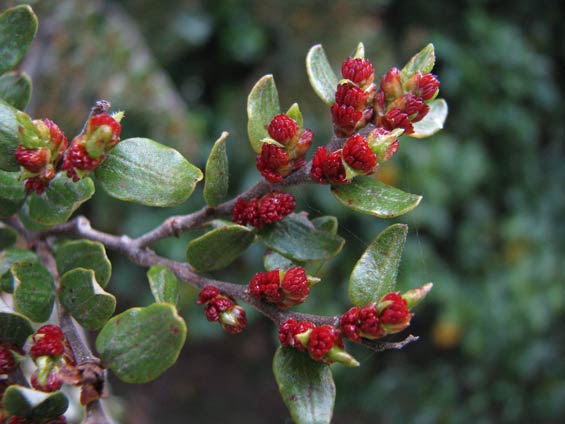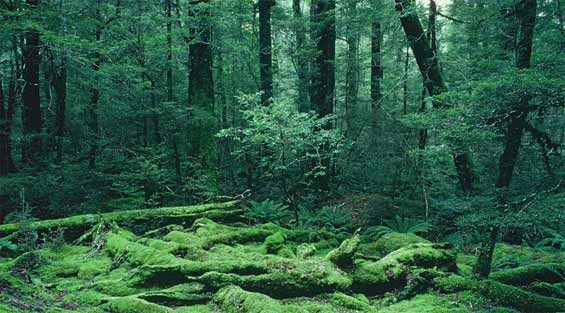
Introduction
New Zealand's beech forests are made up of five species of southern beech.Beech forests are the largest remaining indigenous forest type in New Zealand, mainly because beech forests are found on mountainous land not generally regarded as the best for agriculture.
Quick facts
- A bit less than a quarter of New Zealand is still covered in native forest (6.4 million ha)
- Of these forests, about two thirds have some beech in them (4 million ha)
- About half of these have almost nothing but beech trees (2 million ha)
- Beech trees can produce millions of seeds, and during a heavy seed fall about 50 million seeds (about 250 kg of seeds) will fall per hectare.
Beech species
New Zealand has five species of beech, each prefer different soil and climate conditions.
- Hard Beech (Fuscospora truncata) and black beech (Fuscospora solandri) are found in the lowland areas of the North Island and northern South Island.
- Red beech (Fuscospora fusca) prefers the foothills and inland river valley floors particularly where soils are fertile and well drained. Silver beech (Lophozonia menziesii) prefers higher, wetter conditions.
- Silver beech is the most widespread tall tree in Fiordland.
- Mountain beech (Fuscospora cliffortioides) grows in the mountains and on less fertile soils than silver beech, often forming the tree line at high altitudes.
Bumper seed or 'mast'
Beech trees generally seed every 4-5 years but a cool summer followed by a warm one can lead to intense and widespread flowering throughout beech forests. This causes widespread beech forest seeding or 'masting'.
When a beech mast occurs, it leads to a dramatic rise in mice and rat populations, who feast on the plentiful seed all winter. A single female rat can potentially produce 10 offspring every eight weeks. These predators turn to our native birds for food once the seeds disappear.
Widespread beech forest seeding occurred in 2014 and 2016 and led to our Battle for our Birds national pest control programme, protecting our vulnerable native species from a predator plague.

Mountain beech flowers
Reproductive cycle
Beech trees flower in spring and are wind pollinated. After fertilisation, beech flowers produce seeds in the form of small winged nuts which fall in autumn. The seeds rarely blow more than a few metres before falling to the forest floor where they germinate the following spring. The half light of the forest floor stunts the growth of seedlings until a mature tree falls and light floods in. Once established, a beech tree can grow over 30 metres tall and can live for more than 300 years.
Mistletoe and fungi dependent on beech trees
Three species of native mistletoe depend on beech forests for their survival. Korukoru or crimson mistletoe (Peraxilla colensoi) has scarlet, sometimes yellow, flowers and can reach three metres across. This mistletoe grows almost exclusively on silver beech. Pirirangi or red mistletoe (Peraxilla tetrapetala) has bright red flowers and grows on black, mountain and silver beech. Alepis flavida, has orange-yellow flowers, and is found mainly on mountain and black beech. All three species of mistletoe are threatened with extinction from possum browse.
The beech strawberry fungus (Cyttaria gunnii) has distinctive orange-yellow golf-ball-like fruiting bodies and is only found on silver beech.
A group of fungi, known as mycorrhizae, enjoy a mutually beneficial relationship with beech trees. Living on the tree roots, the fungi take sugars while in return the beech tree absorbs minerals, which the fungus has transported from the surrounding soil.

Beech forest, Eglinton Valley, Fiordland National Park
Honeydew
The beech scale insect plays a vital role in the food supply for a range of native bird and insect species. The native insect lives in the bark of beech trees drawing off the sap. The insect then excretes sugary liquid drops, known as honeydew.
Beech scale insects infest all species of beech tree except silver beech. They are particularly common on beech at the foothills of the Southern Alps. The honeydew drops have a high sugar content and are an important energy source for birds including tui, bellbirds and kaka. Lizards, possums, rats, honeybees and wasps have also been recorded feeding on honeydew.
Threats
- Possums do enormous damage to native New Zealand forests. Apart from damaging the trees and other flora, they compete with native animals and birds for food, and prey upon birds, their eggs and nestlings.
- The high wasp numbers in some forests, such as Nelson Lakes National Park, have depleted the honeydew and dramatically reduced the abundance of insects and spiders. This has had flow on effects on birds that eat the honeydew and insects. Trees have been seen with around 400 wasps crawling over them.
- Land clearance has reduced the size of our native beech forests, particularly in the foothills of the Southern Alps.
- Browsing by introduced mammals such as deer and sheep seriously limit the capacity of a beech forest to regenerate.
- Fire is an obvious threat to beech forest and fire restrictions apply all year round to many areas of land managed by the New Zealand Department of Conservation.
You can help
When enjoying beech forests, take note of any signs warning of poison and other Department of Conservation signs. Do not interfere with native birds or the traps and bait stations that are there to protect them. Dogs are not allowed in national parks and restrictions may apply elsewhere. In places where they are allowed, dogs must be under control.
When enjoying the outdoors, pay attention to fire warnings and local weather conditions. Trampers, hunters, fishers and other explorers of the backcountry are asked to carry in personal cooking equipment and only operate stoves well clear of vegetation. Land owners should be aware that in New Zealand permits are required to light fires within one kilometre of public conservation land. It is important to remember that fire authorities can seek to recover costs if a fire gets out of control.